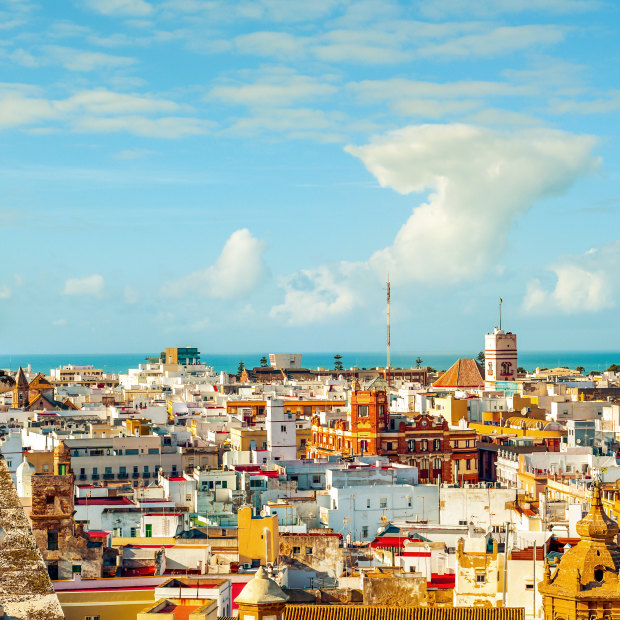
Cadiz.Credit: iStock
It’s standing room only at the bar, glasses of the golden, dry sherry called fino and plates of tissue-thin jamon at our elbows.
To my left, a doctor from Malaga says he comes here every time he’s in Jerez. To my right, locals drop in for a drink and a song.
Low stools are huddled closer to the small stage for those who like to book ahead, but the rest of us stand; it’s a loud, friendly scene while the flamenco musicians warm up. Then Maria bursts through the crowd to demand our absolute attention. And she gets it.
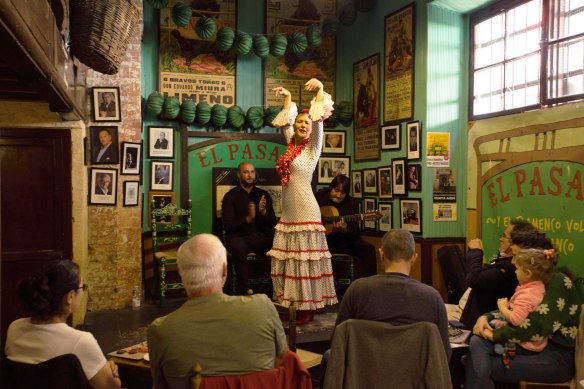
A flamenco dancer commands Tabanco El Pasaje’s timber stage.Credit: Frank Sanchez/Alamy
Hot, raucous, commanding. For the next 45 minutes, her buckled shoes will crash against Tabanco El Pasaje’s timber stage, her red and black skirt snapping and flicking as the cantaor sings;
I’m waiting for you, it’s two o’clock, and three and four, and you are not coming.
I just want to see you dancing,
See you dancing,
See you dancing…
Maria is just one of the highlights of my six-day solo adventure by train and foot through the three Andalusian cities of Seville, Jerez de la Frontera and Cadiz, which is ruled by two “F” words – fino and flamenco.
I’m on a self-guided journey by British slow-travel company Inntravel, which includes detailed walking guides, pre-booked stays in boutique hotels and a trifecta of train tickets for travel between the three cities on Spain’s excellent train network.
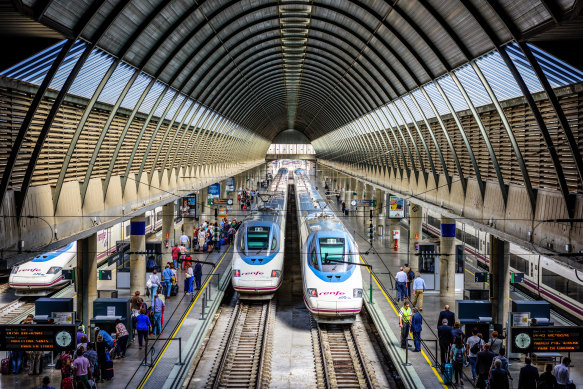
Seville’s Santa Justa station has high-speed links to Madrid.Credit: Getty Images
Travelling solo, I have the luxury of dallying in station cafes over coffee to soak up the theatre of travel – from the busyness of Seville’s modern Santa Justa station, with its high-speed links to Madrid and its airport-like arrivals and departures board, to the overlooked glory of Andalusian tiles in Jerez, surely one of Spain’s most beautiful railway stations, and the holiday vibe of seaside Cadiz’s station, the end of the line at the Atlantic Ocean.
Spain’s major cities are connected by an impressive high-speed rail network but my journey slows it all down on the media distancia (mid-distance) routes between the smaller cities and towns. Travelling off-peak, I’m sharing the trains with locals on the short hops of less than an hour between each city.
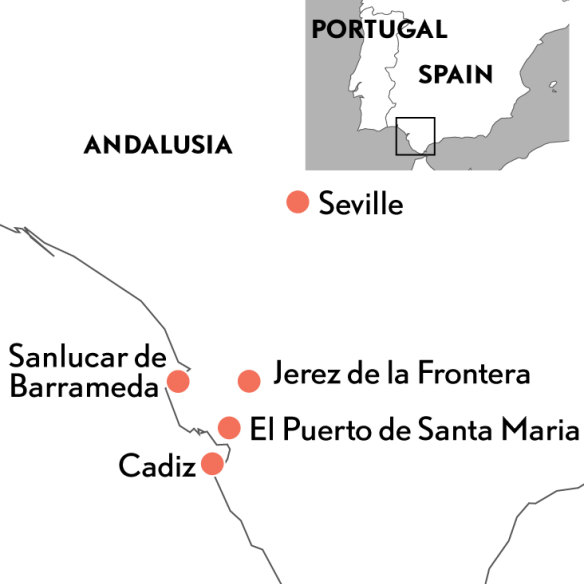
Seville – Moorish and moreish
“You’re a single person, your place is at the bar,” instructs my friend Pablo before I arrive in Spain’s golden city, Seville, on a red-eye flight from Dublin. “Just walk in and take your seat.”
El Rinconcillo has been doling out tapas since 1670, so I join a long queue outside, but I am soon skipping past the groups waiting to be seated. Tables? Pah! Who needs them?

Fino ... a pale and dry style of sherry produced in Jerez.Credit: Getty Images
Standing at the tile-embellished counter, I watch a trio of men running the bar – literally running – but they still find time to compliment my tapas choice, the very homely Sevillian dish of spinach and chickpeas, as they scratch my bill directly on the counter with a wedge of white chalk, wiped clean once I’ve paid.
There’s touristy Cerveceria Giralda, where you dine beneath the domed ceilings and mosaics of a 12th-century hammam from Moorish Seville. In the 145-year-old Las Teresas bar, I order a glass of cool, dark vino de naranja, Seville’s signature bitter orange-infused wine. Aged in sherry barrels for four years, it has a sugar hit that kicks off my flamenco journey.
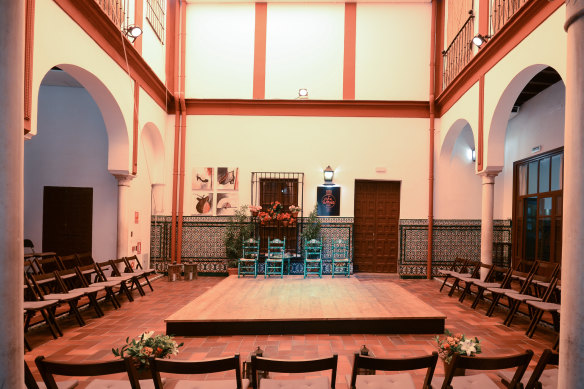
Guests gather around La Casa del Flamenco’s central performance hall.Credit: Getty Images
At La Casa del Flamenco, just 50 seats are pulled so close to a timber stage that the dancers flick pearls of sweat onto us, their rapid hand-clapping (palmas) echoing through the 15th-century townhouse.
Seville dancer Suzana Casas takes the stage in a long, black and white polka dot skirt, while her male counterpart, El Junco, wears a dishevelled suit coat over a flamboyant shirt. With his unshaven chin and brooding brow, El Junco is far from the polished matadors we’re usually served up, a reminder that the genre was born from the narrow streets of these cities’ gitano (gypsy) quarters.
La Casa isn’t pricey or a dinner-and-show; it’s perfect for the solo traveller. And set in Seville’s Santa Cruz neighbourhood, it’s also close to my hotel, Las Casas de la Juderia.
This is Seville’s former Jewish quarter, and the 134-room hotel is a collection of 27 houses built between the 15th and 18th centuries, connected by more than 40 staircases and tunnels, patios and courtyards. It is a genuine maze, and my room key comes with a hotel map. I’ll descend a stairwell to find a subterranean spa, ascend another to reach a rooftop pool.
In the Royal Alcazar, I play games with the crowds: can I get a photo without a single tour guide? And I pretend I’m in the Water Gardens of Dorne (fellow Game of Thrones fans, you get it).
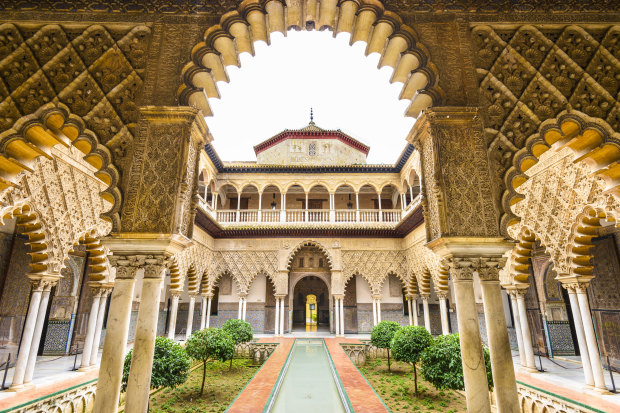
The Royal Alcazar of Seville at the Courtyard of the Maidens.Credit: Getty Images
In the cathedral, it’s hello to Christopher Columbus, entombed among riches, before climbing the 35 ramps of La Giralda, the bell tower, originally a minaret for the mosque that stood here from 1176.
In this city of gastronomical delights, my most memorable meal is not in my notes or recommended by Spanish friends – it’s at a late-night bar, or cerveceria.
Am I the only patron here without a tattooed neck? The TV is playing a football match post-mortem and Antonio, the resident barfly, tries his luck. “Me gustaaaaaaas (I like you),” he breathes beerily at me before falling asleep standing at the bar.
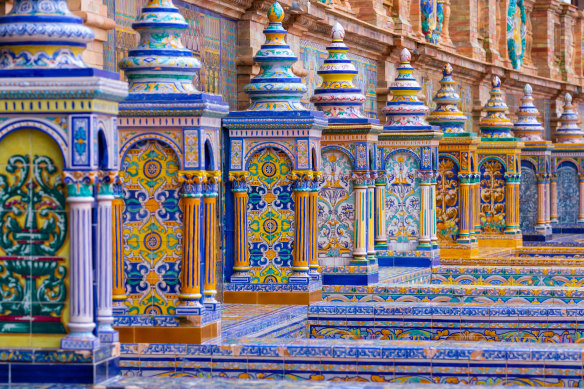
Vibrant multi-coloured benches of the famous Seville square, Plaza de Espana.Credit: Getty Images/iStockphoto
A young delivery driver takes his place and, following his lead, we start to order. Small glasses (canas) of Seville’s Cruzcampo lager. Berenjenas fritas – sticks of battered eggplant garnished with black honey, and chipirones – tender baby squid lightly charred and doused with salsa verde so garlicky it would put even Antonio off a late-night rendezvous.
Seville is so famously packed with treasures, a few days cannot do it justice. So, on my final morning, I’m uncharacteristically up at dawn to jog the empty streets following Inntravel’s recommended walking route.
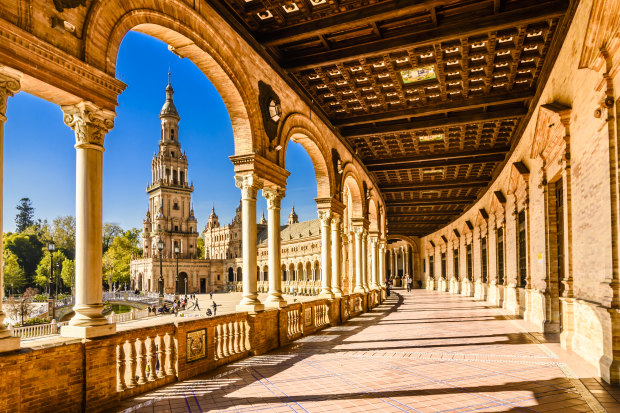
Grand columns and arches of Plaza de Espana.Credit: Getty Images
Covering 5.7 kilometres, I pass the beautiful Maestranza bullring and run alongside the Guadalquivir River, past the Jardines de Murillo, the Palace of San Telmo and to the Plaza de Espana. I have a train to catch, so I skip the section through Triana, Seville’s gitano stronghold.
It’s with a heavy heart that I scan my ticket at Seville’s modern Santa Justa, Spain’s third-busiest station for the 9.45am punctual departure. The airline-like seats on Media Distancia routes are always allocated.
Mine is a backward-facing seat in a group of four, set around a small table, ideal for the quiet contemplation that half-empty trains enable. An overhead screen announces each station, and a cheery conductor scans our tickets as we pass rows of neat olive trees and the hot, flat plains of Andalusia pass, hitting 159 kilometres an hour, bound for the source of sherry.
Jerez – The birthplace of sherry
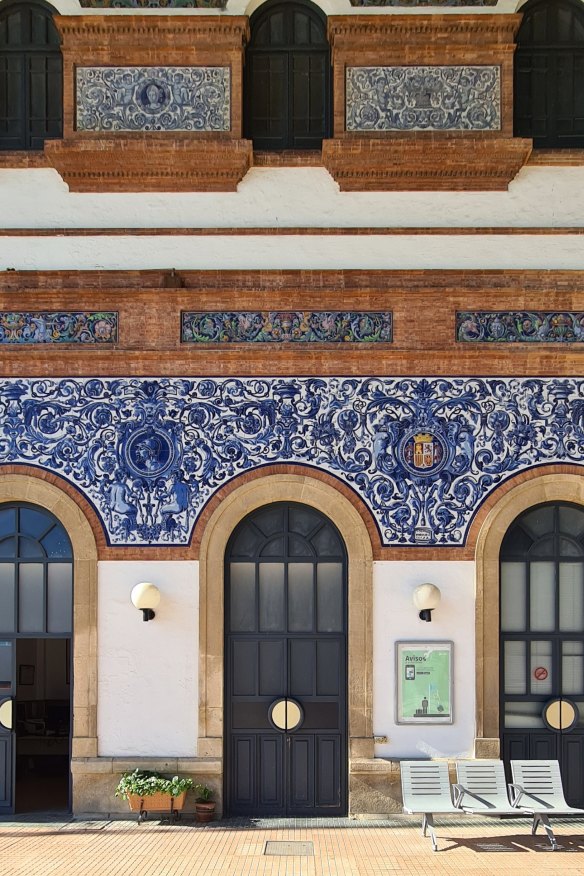
Beautiful tile work at Jerez station.Credit: Unsplash
At first glance, Jerez de la Frontera melts the train traveller’s heart. Its railway station is breathtaking for tile tragics like me. Railways came early to Jerez, to whisk its sherry down to Spain’s southern ports, and this station was built in the early 1900s. It is an azure riot of hand-painted curlicues and geometric tiles across arches, towers and colonnades.
But away from the glamour of the railway station, Seville is a tough act to follow – Jerez is a hardworking industrial town without Seville’s gloss and beauty.
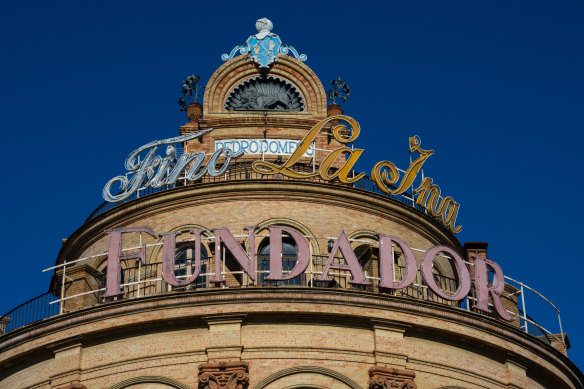
Jerez de la Frontera.Credit: Getty Images
If sherry and your great aunt are intrinsically entwined in your mind, you need to be here in the Sherry Triangle. It takes just 90 minutes to drive between the holy trinity of sherry-making towns of Sanlucar de Barrameda, El Puerto de Santa Maria and of course, Jerez de la Frontera. I say “of course”, because Jerez gave its name to the amber liquid.
One story goes that renowned English pirate Sir Francis Drake sacked Cadiz in 1578, hauling a booty of 3000 casks of sherry back to Queen Elizabeth I. They could roll the aged wine on their tongues, but the English couldn’t get their tongues around the town’s name, and so Jerez – named Xeres under the Romans, Sherrish in Islamic times, and now pronounced “hereth” – was corrupted yet again into “sherry”.
Happily, this city rewards the flaneur. Darkened churches safeguard outrageously ornate, gold-spattered altars overlooked by sorrowful Madonnas. Grand, tiled porticos with wrought-iron doors are the elegant public faces of the private homes beyond.
On a quiet Sunday afternoon, when siesta is meticulously observed, Jerez’s flamenco dress shops are closed and the city’s Islamic-era Alcazar fails to excite, so I wander the barrios (neighbourhoods), the silence broken only by the clatter of castanets and heels on wood.
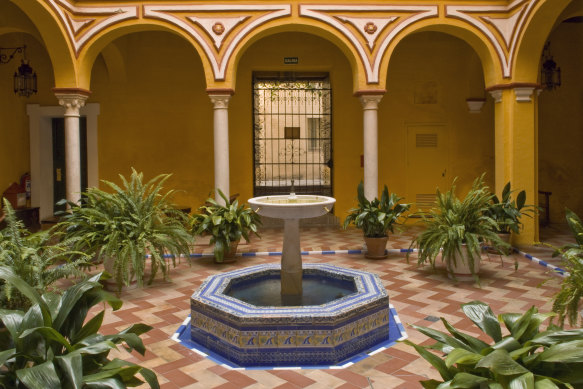
Ornate courtyard of Las Casas de la Juderia.
Castanets? This barrio of San Miguel is one of the cradles of flamenco, along with Seville and Cadiz. The sounds of the dance school echo through the cobbled streets, watched over by the statue of renowned singer and dancer Lola Flores.
For all its gritty realism, Jerez does have its touristy dives – at the much-hyped Bar Juanito, the white beans and prawns come with a cheesy guitarist. And while I’m pony-mad and the snowy horses are glorious, the dressage show at the Royal Andalusian School of Equestrian Art leaves me cold, as I watch the imposition of human will over the regal horses, who plie and roll on command.
Yet, just a 15-minute walk from the station, the Calle Larga is a lovely, long promenade dominated by the glorious 1929 El Gallo Azul building, where people sit at old sherry barrels to sip short beers and even shorter coffees. Every bar is lined with posters of local matadors and the giants of sherry – Tio Pepe, La Gitana, La Ina.
Hemmed in by more fino barrels at Tabanco El Pasaje, where dancer Maria flicks her ruffled skirts, I fall in with a couple of South American bon vivants. While I’ve been doing OK on my own, Spain was designed for groups.
It lets us order everything on the menu to share. At the raucous Tabanco Las Banderillas, we throw all our desires at the waiter. Anchovies to start! A whole fish! All the clams! Preferably freestyling in a sea of butter, parsley, garlic and fino.
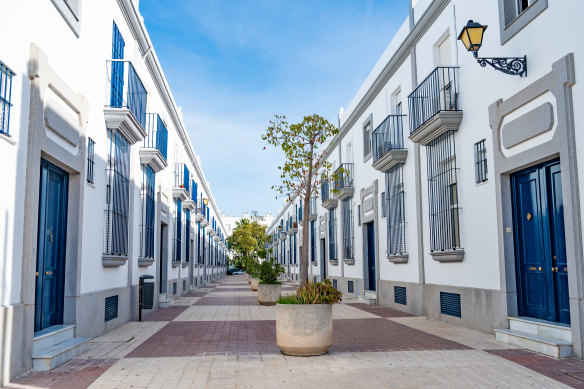
The white streets of Puerto de Santa Maria in Cadiz.Credit: Getty Images
“What about chipirones?” he asks. Doubting we’ll finish all the food already on the table, I hesitate to order the baby squid. “Wait! Let me show you! They’re fresh, you know!” and he disappears at a run, to reappear with said fresh baby squid on a plate, and insists on a photo of him, me, and the baby squid, which reappears at the table, soft, sweet and charred to perfection.
I’ve been happily exploring a range of sherries, including pale gold Manzanilla produced only in Sanlucar, and rich, lush Oloroso, for a euro or two a glass at the city’s bars, but it’s time for a sherry crash course.
Right in Jerez’s centre, and less touristy than Bodegas Tío Pepe, I’m the only visitor in the cool, 18th-century vaults of Bodegas Díez-Merito this morning. Guide Maria racks up the seven styles of sherry, from the youthful, bone-dry fino to Amontillado, Palo Cortado and the sweetest of them all, Pedro Ximenez (PX).
It may be only 9am, and I may have stopped in on my walk to the railway station, but I’m already squirrelling away her pairing recommendations of fino and sushi, PX with vanilla ice-cream.
Back to the glorious station’s waiting room, two nuns and I enjoy mid-morning coffee as plump nymphs and mythical creatures gambol and strum lyres in the frescoes overhead, until my train, the 10.45am to Cadiz, pulls in for the short journey to the ocean.
Cadiz – To the sea, to the sea
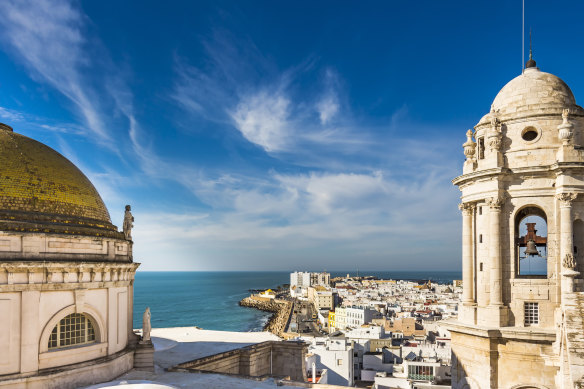
Sweeping views of the Bay of Cadiz from Levante Tower.Credit: iStock
It’s one of western Europe’s longest-standing cities, and Spaniards adore it. Vast sea walls curl a protective arm around pretty Cadiz’s medieval cobbled lanes lined with bijou shops, its city beaches and elegant gardens designed for tongue kissing and languid perambulation.
It’s 45 minutes by train from Jerez to Cadiz, and its 21 degrees in mid-November. The train curves around the Bay of Cadiz, past white salt pans and canals, along beaches tousled by warm Atlantic breezes and the narrow isthmus that saves Cadiz from being a 10-kilometre-long island, pummelled by the roiling, grumbling Atlantic Ocean.
Ten minutes’ walk from the train station to my little hotel, I fall hard and fast for it all. Formerly, the 21-room Hotel Argantonio was a nobleman’s city pad. Its 18th-century stable is now the bar, and the city’s tightly knotted streets are best viewed from its rooftop garden.
The Phoenicians founded Cadiz, rocking up from modern-day Lebanon around 1100BC. Happily, they also packed vines in their luggage, kick-starting the sherry train.
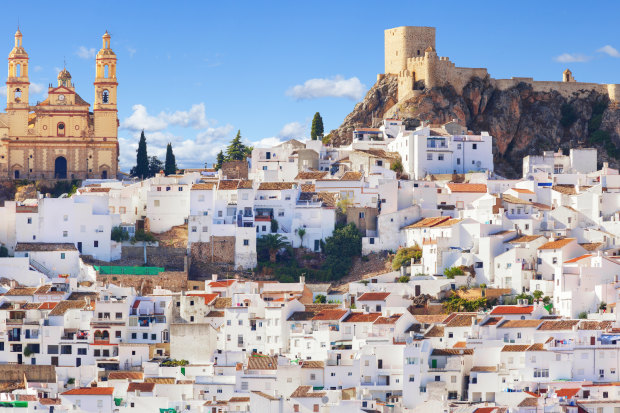
The seaside town of Cadiz is a popular stop for cruise liners.Credit: iStock
This is still a seafaring town; a home port of the Spanish Navy, foreign cruise liners moor at the docks, its guest book signed by the biggest names in naval history – think Hannibal, Julius Caesar, Christopher Columbus and, apparently, even the mythical Hercules, whose ninth-century BC temple was uncovered here last year.
Napoleon sought refuge at this slaving outpost, renowned for its dancing girls, ahead of the epic sea battle in 1805 at Cape Trafalgar, just 50 kilometres away.
I can see why they all dallied here – the gold-domed cathedral glitters and Cadiz’s ice cream bar rivalry is strong. Jaunty, striped umbrellas fill the plazas where Spanish holidaymakers sip a little fino – most comes from El Puerto de Santa Maria, just 20 minutes away – and the sea yields the hyper-local tapas of cuttlefish meatballs and shrimp fritters. “When in Rome – or Cadiz,” I think, from beneath my umbrella.
Following the restaurant-lined Calle Plocia, my walking notes lead me into the Barrio de Santa Maria, Cadiz’s flamenco heartland. The late flamenco documenter Pierre Lefrance described flamenco singing as “deep grief … simultaneously expressed and controlled”.
He might have been describing one of the city’s favourite daughters, the singer or cantaora Antonia Gilabert Vargas, aka La Perla de Cadiz, whose statue heralds the barrio.
At the nearby Plaza de la Merced, the old market building is now a working flamenco centre. Portraits of the greats of the genre hang outside and there are dance and singing classes inside, but it’s quiet on this lazy, sunny afternoon.
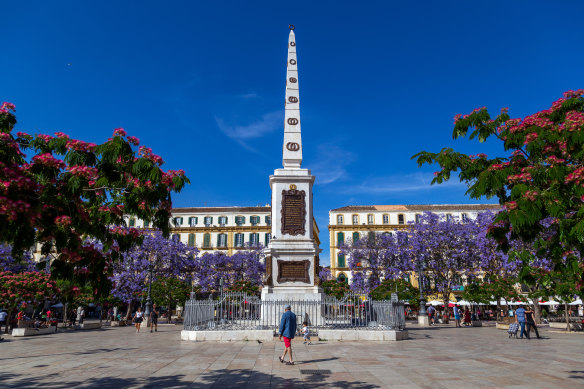
A sunny afternoon at the Plaza de la Merced.Credit: Getty Images
From the market, it’s just a few minutes’ walk to another performance space, the fabulous Roman theatre, built in 70BC to seat 20,000 people. It is now quiet, a place for contemplation of my five days of flamenco and fino, two art forms unique to southern Andalusia.
Both misunderstood or misrepresented as the tipple of maiden aunts and the jig of itinerant gypsies, the dance and the drink are imprinted on the landscape from which they were born, and now, through my tour, they are imprinted upon me.
Five more beautiful Spanish train stations to explore
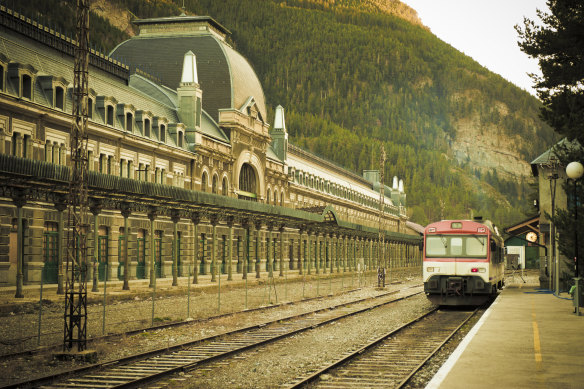
Straight out of a Wes Anderson film .... the Canfranc railway station.Credit: Getty Images
Orange County Valencia’s famed oranges and ceramic tiles are on display at Estacio del Nord, designed in 1917 in the Valencian art nouveau style.
Capital destination Madrid’s Estacion de Atocha was built in 1892 by Alberto de Palacio Elissagne in collaboration with Alexandre Gustave Eiffel. The train sheds now host cafes, shops and an acre of steamy tropical gardens.
Border lands Straight out of a Wes Anderson film, the Beaux-Arts Canfranc railway station on the French border was neglected for decades, before reopening as a hotel in 2023, see barcelo.com
Holy toledo More cathedral than railway station, Toledo’s stop was designed in 1919 in the Neo-Mudejar style by architect Narciso Claveria y de Palacios.
Glass act The Bilbao-Abando station’s crowning glory is its 15-metre stained-glass window, made in 1948 by Jesus Arrecubieta, overlooking the platforms.
The details
Tour
Inntravel’s self-guided six-night Fino & Flamenco tour travels between Seville, Jerez and Cadiz by train. Includes pre-booked train tickets, six nights’ bed and breakfast and suggested walking tours. The trip starts any day of the week from Seville. From $1300 (excludes flights). See inntravel.co.uk
Stay
Las Casas de la Juderia, Seville, is a gloriously ornate maze of 134 rooms among 40 houses in the old Jewish quarter; don’t miss breakfast in its mirrored, subterranean room, from $170 a night. See lascasasdelajuderiasevilla.com
Casa Grande, Jerez, is an Andalusian-style townhouse around a central courtyard with just 15 rooms, a short walk to the markets and main promenade, from $95 a night. See hotelcasagrandejerez.com
Hotel Argantonio, Cadiz, is an 18th-century house in the knotted, cobbled streets of Cadiz’s historic centre from $95 a night. See hotelargantonio.com
Flamenco
La Casa del Flamenco, Seville, €22 ($36.50) for adults; Tabanco El Pasaje, Jerez, free if you’re standing. See lacasadelflamencosevilla.com; tabancoelpasaje.com
Eat + drink
In Seville, El Rinconcillo (elrinconcillo.es), La St Teresas (lasteresas.es).
In Jerez, Tabanco Las Banderillas (no website).
In Cadiz, La Taperia de Columela (no website). Qualified sherry educator Annie B runs tapas and tabanco tours through Jerez and Cadiz (anniebspain.com)
Fly
All major carriers fly with one stop in Asia or the Middle East from Melbourne or Sydney to Madrid, which is connected by high-speed train (renfe.com) to Seville (two hours 30 minutes). Various airlines including British Airways (britishairways.com) and Ryanair (ryanair.com) fly to and from Seville.
More
spain.info
The writer travelled as a guest of Inntravel.